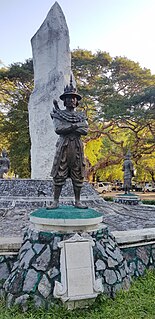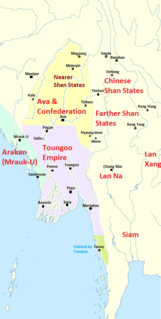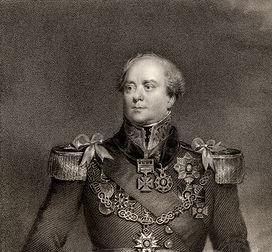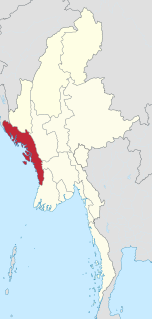
The First Anglo-Burmese War, also known as the First Burma War, was the first of three wars fought between the British and Burmese empires in the 19th century. The war, which began primarily over the control of Northeastern India, ended in a decisive British victory, giving the British total control of Assam, Manipur, Cachar and Jaintia as well as Arakan Province and Tenasserim. The Burmese were also forced to pay an indemnity of one million pounds sterling, and sign a commercial treaty.

Tabinshwehti was king of Toungoo Dynasty of Burma (Myanmar) from 1530 to 1550, and the founder of Toungoo Empire. His military campaigns (1534–49) created the largest kingdom in Burma since the fall of Pagan Empire in 1287. His administratively fragile kingdom proved to be the impetus for the eventual reunification of the entire country by his successor and brother-in-law Bayinnaung.

The battle of Prome was a land-based battle between the Kingdom of Burma and the British Empire that took place near the city of Prome, modern day Pyay, in 1825 as part of the First Anglo-Burmese War. It was the last-ditch effort by the Burmese to drive out the British from Lower Burma. The poorly equipped Burmese army despite the advantage in numbers suffered a defeat. The British army's subsequent march toward north threatened Ava, which led to peace negotiation by the Kingdom of Burma.
The Treaty of Yandabo was the peace treaty that ended the First Anglo-Burmese War. The treaty was signed on 24 February 1826, nearly two years after the war formally broke out on 5 March 1824, by General Sir Archibald Campbell on the British side, and the Governor of Legaing Maha Min Hla Kyaw Htin from the Burmese side. With the British army at Yandabo village, only 80 km (50 mi) from the capital Ava, the Burmese were forced to accept the British terms without discussion.
Myawaddy Mingyi U Sa was a Konbaung-era Burmese poet, composer, playwright, general and statesman. In a royal service career that spanned over six decades, the Lord of Myawaddy served under four kings in various capacities, and was a longtime secretary to King Bagyidaw. Multi-talented Sa is best remembered for his innovative contributions to classical Burmese music and drama, as well as for his brilliant military service.

General Maha Bandula was commander-in-chief of the Royal Burmese Armed Forces from 1821 until his death in 1825 in the First Anglo-Burmese War. Bandula was a key figure in the Konbaung dynasty's policy of expansionism in Manipur and Assam that ultimately resulted in the war and the beginning of the downfall of the dynasty. Nonetheless, the general, who died in action, is celebrated as a national hero by the Burmese for his resistance to the British. Today, some of the most prominent places in the country are named after him.
Nanda Bayin, was king of Toungoo Dynasty of Burma (Myanmar) from 1581 to 1599. He presided over the collapse of Toungoo Empire, the largest empire in the history of Southeast Asia.
Maha Thiha Thura was commander-in-chief of the Burmese military from 1768 to 1776. Regarded as a brilliant military strategist, the general is best known in Burmese history for defeating the Chinese invasions of Burma (1765–1769). He rose to be a top commander in the service of King Alaungpaya during the latter's reunification campaigns of Burma (1752–1759), and later commanded Burmese armies in Siam, Lan Na, Luang Prabang (Laos), and Manipur.
Minkhaung I of Ava was king of Ava from 1400 to 1421. He is best remembered in Burmese history for his epic struggles against King Razadarit of Hanthawaddy Pegu in the Forty Years' War (1385–1424). As king, Minkhaung continued his father Swa Saw Ke's policy to restore the Pagan Empire. Under the military leadership of his eldest son Minye Kyawswa, Ava nearly succeeded. While he ultimately failed to conquer Hanthawaddy and Launggyet Arakan, he was able to bring in most of cis-Salween Shan states to the Ava orbit.

Minye Kyawswa was crown prince of Ava from 1406 to 1415, and commander-in-chief of Ava's military from 1410 to 1415. He is best remembered in Burmese history as the courageous general who waged the firecest battles of the Forty Years' War (1385–1424) against King Razadarit of Hanthawaddy Pegu.

The Battle of Naungyo was a land battle fought between the armies of the Toungoo Kingdom and Hanthawaddy Kingdom during the Toungoo–Hanthawaddy War (1534–41) in late 1538. The battle was the most decisive Toungoo victory of the war. Toungoo armies led by Gen. Kyawhtin Nawrahta decisively defeated a numerically far superior and better armed force of Hanthawaddy led by Gen. Binnya Dala and Gen. Minye Aung Naing. Only a small portion of the Hanthawaddy forces made it to their intended destination–the fortified city of Prome (Pyay). A decimated Hanthawaddy was no longer in a position to retake the lost territories from Toungoo.
The Prome Kingdom was a kingdom that existed for six decades between 1482 and 1542 in present-day central Burma (Myanmar). Based out of the city of Prome (Pyay), the minor kingdom was one of the several statelets that broke away from the dominant Ava Kingdom in the late 15th century. Throughout the 1520s, Prome was an ally of the Confederation of Shan States, and together they raided Avan territory. After Ava fell to the Confederation armies in 1527, Prome itself became a tributary of the Confederation in 1532. In the late 1530s, Prome became ensnarled in the Toungoo–Hanthawaddy War (1534–41). Despite military assistance from the Confederation and the Mrauk U Kingdom, the small kingdom fell to the Toungoo (Taungoo) forces in 1542.

The Sino-Burmese War, also known as the Qing invasions of Burma or the Myanmar campaign of the Qing dynasty, was a war fought between the Qing dynasty of China and the Konbaung dynasty of Burma (Myanmar). China under the Qianlong Emperor launched four invasions of Burma between 1765 and 1769, which were considered as one of his Ten Great Campaigns. Nonetheless, the war, which claimed the lives of over 70,000 Chinese soldiers and four commanders, is sometimes described as "the most disastrous frontier war that the Qing dynasty had ever waged", and one that "assured Burmese independence". Burma's successful defense laid the foundation for the present-day boundary between the two countries.
Ne Myo Thihapate, also spelled Nemyo Thihapte and Nemiao Sihabodi, was a general in the Royal Burmese Army of Konbaung Dynasty of Burma (Myanmar). The general is best known for conquering the Ayutthaya Kingdom, along with Gen. Maha Nawrahta, in April 1767.
The military history of Myanmar (Burma) spans over a millennium, and is one of the main factors that have shaped the history of the country, and to a lesser degree the histories of the country's neighbours. At various times in history, successive Burmese kingdoms were also involved in warfare against their neighbouring states in the surrounding regions of modern Burmese borders—from Bengal, Manipur and Assam in the west, to Yunnan in the northeast, to Laos and Siam in the east and southeast.
Thado Dhamma Yaza I was viceroy of Prome (Pyay) from 1542 to 1550 during the reign of his son-in-law King Tabinshwehti of Toungoo Dynasty of Burma (Myanmar), and the self-proclaimed king of the city-state from 1550 to 1551. After the death of Tabinshwehti in 1550, the man who started out as a royal household servant of Tabinshwehti in 1516 declared himself king of Prome with the style of Thado Thu, and did not submit to Bayinnaung, Tabinshwehti's chosen successor. His fortified city-state fell to Bayinnaung's forces in 1551 after a six-month battle. He was executed on the order of Bayinnaung, who later regretted the decision.

The Toungoo–Ava War (1538–1545) was a military conflict that took place in present-day Lower and Central Burma (Myanmar) between the Toungoo Dynasty, and the Ava-led Confederation of Shan States, Hanthawaddy Pegu and Arakan (Mrauk-U). Toungoo's decisive victory gave the upstart kingdom control of all of central Burma, and cemented its emergence as the largest polity in Burma since the fall of Pagan Empire in 1287.
The Battle of Ramu, fought in May 1824, was one of the opening battles of the First Anglo-Burmese War. On May 10, 1824, the Burmese under General Maha Bandula launched an invasion of Chittagong from Arakan as the southern part of a two-pronged attack aimed at Calcutta. They offered to end the invasion if the British were to hand over some Arakanese rebels that had taken refuge in the Bengal Presidency. The British commander at Ramu, Captain Noton, rejected the offer, and the Burmese attacked. After three days of fighting the British troops, a mixed force with a total strength of several hundred men, was routed and forced from Ramu on May 17. The British losses in killed, wounded and missing amounted to more than half the strength of the garrison. The Burmese however failed to exploit their advantage, and Maha Bandula's army would withdrew to counter the British occupation of Rangoon.














